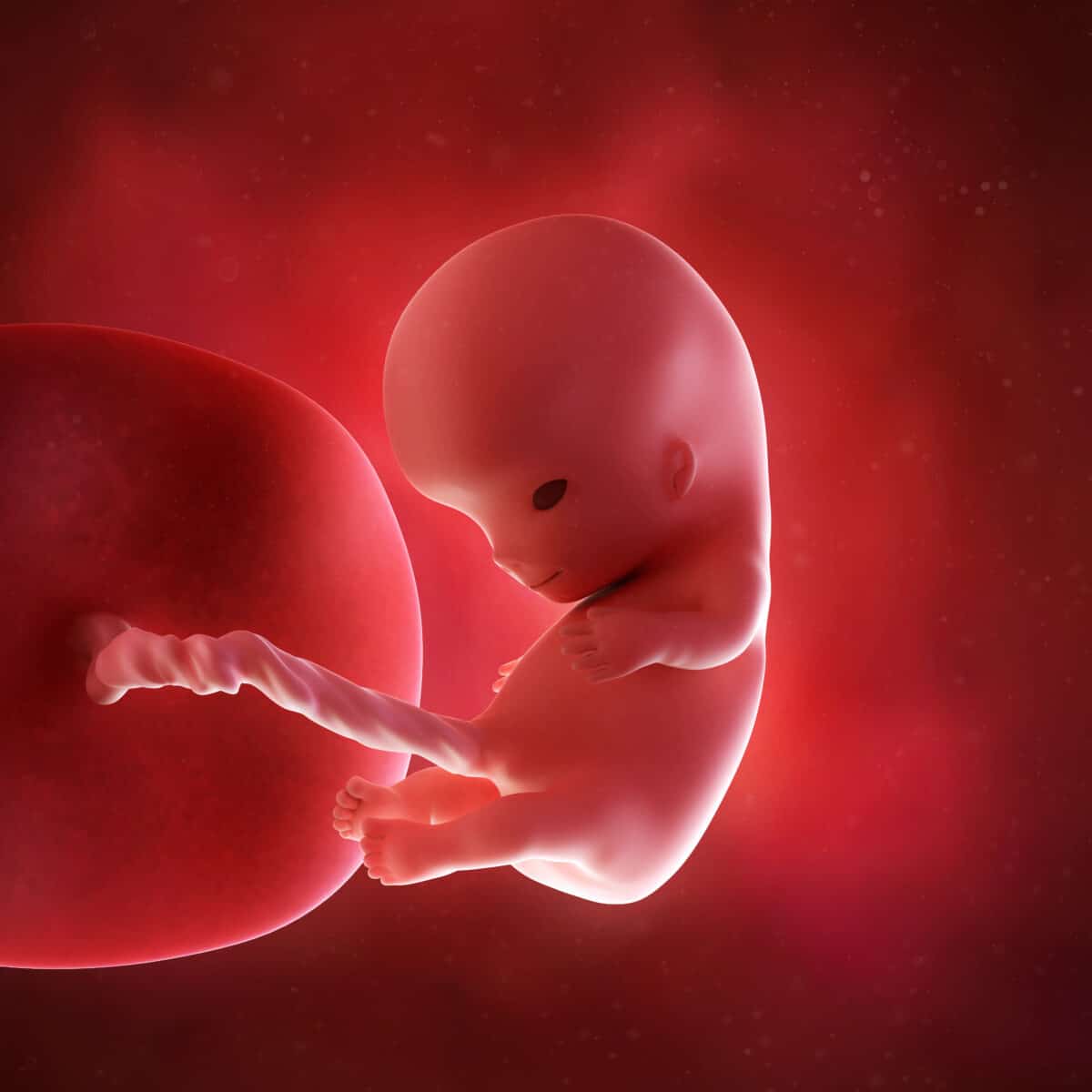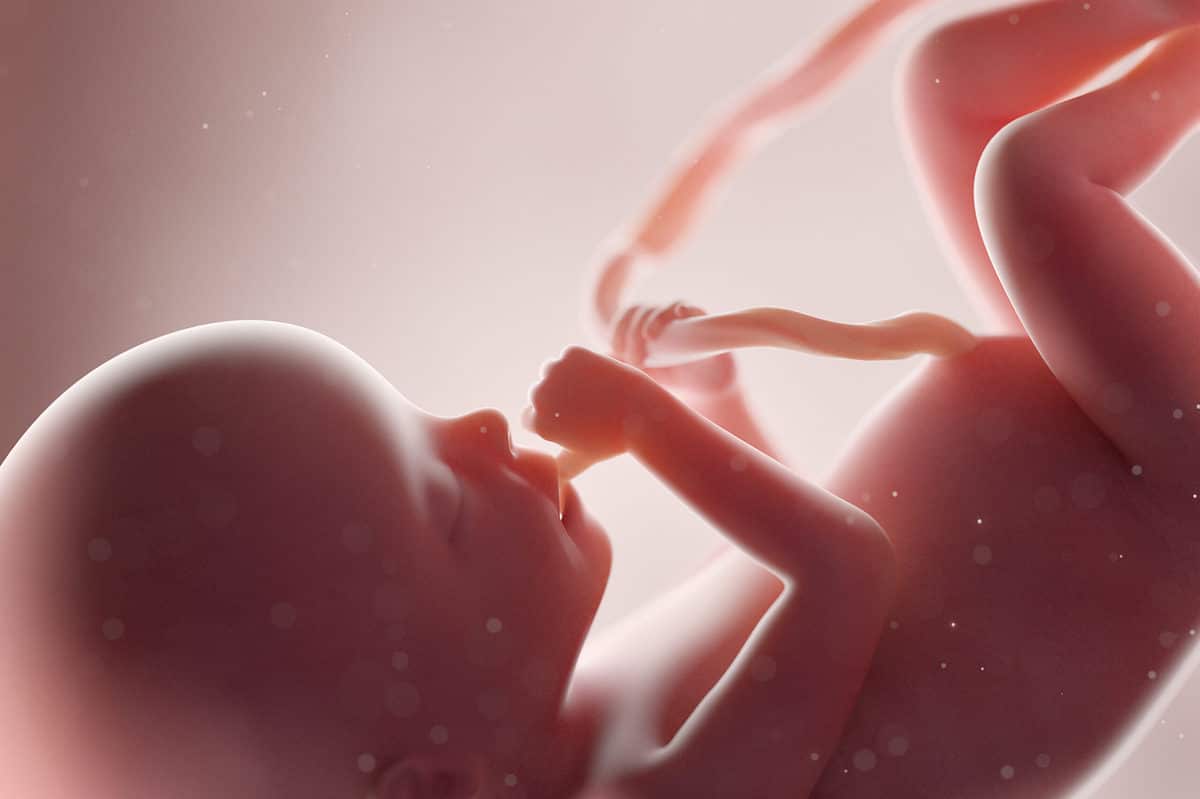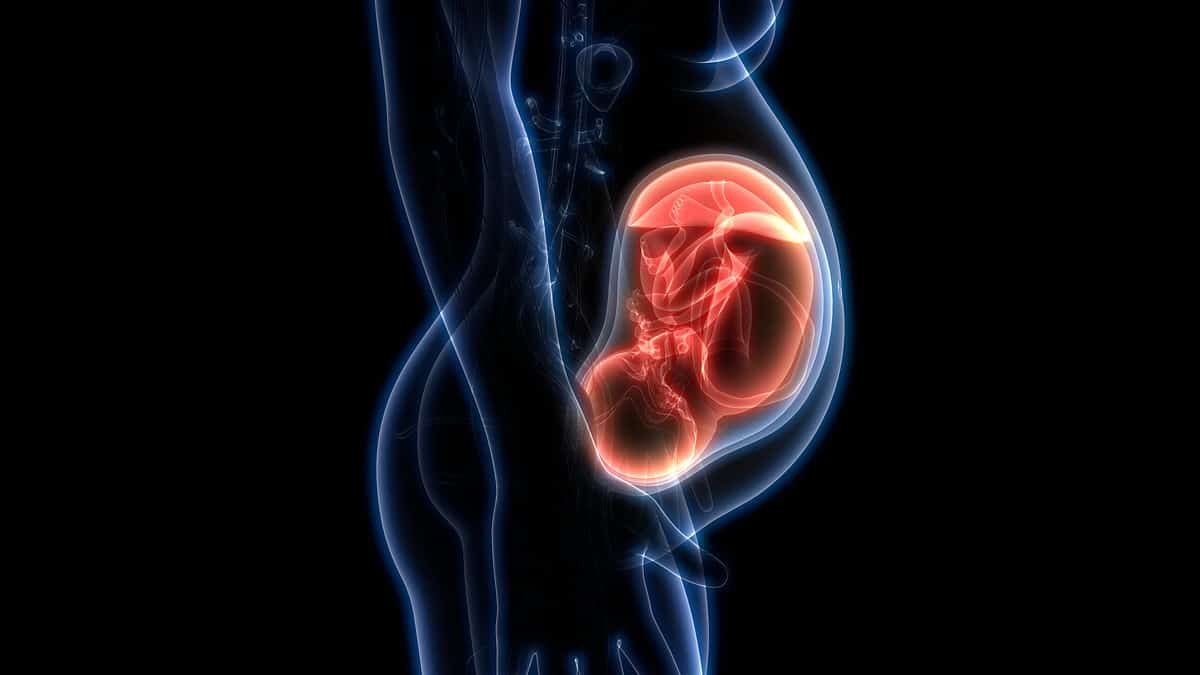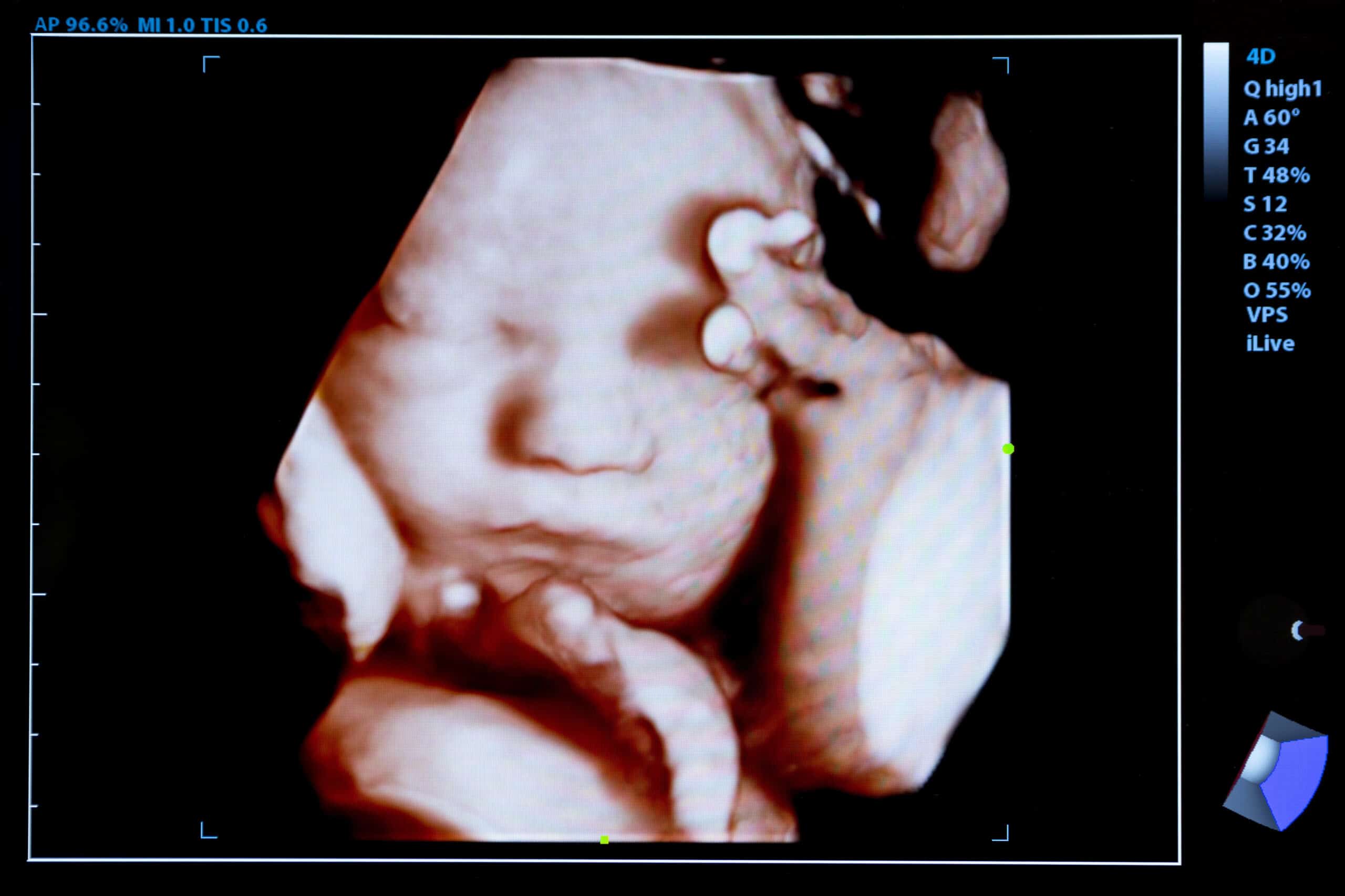Pregnancy is a remarkable and exciting journey – not just for you, but also for the new life growing within the mother. For your unborn child, it’s a long road from conception to due date. Read on to learn all about the fetal developmental milestones that lead to your baby’s birth.
We’ll look at all of these developments trimester-by-trimester and week-by-week, from the earliest stages of pregnancy onward.
Key Points:
- Fertilization takes place at week 3, while implantation happens in week 4.
- In week 9, the fetus will begin developing more recognizable details.
- By the beginning of the third trimester, the baby can move on its own and may begin kicking.
Fetal Developmental Milestones in the First Trimester

©SciePro/Shutterstock.com
During the first 12 weeks, your child goes from not even conceived at all to microscopic to recognizable as a human baby. Buckle in for a fast-paced ride and read on!
Weeks 1-4: Pregnancy Begins
Conception typically happens in the first two weeks after the mother’s last period. For this reason, doctors count the first 2 weeks after that period in the 40 weeks of pregnancy. But that ultimately means that mom is probably not actually pregnant in the first two weeks of her medically defined pregnancy. Strange but true!
And so, this first round of fetal developmental milestones starts with week 3.
- Week 3 (fertilization): The sperm and egg cell join in one of the fallopian tubes. Together, they form a zygote, which begins to travel through the tube and toward the uterus. As the zygote heads toward its destination, it continues to divide, becoming a morula, a cluster of pre-embryonic cells.
- Week 4 (implantation): The morula divides and expands into a blastocyst that implants itself into the lining of the wall of the uterus – the uterine endometrium. The inner layer of cells will soon become the embryo, and the outer layer will go on to form the placenta that sustains the embryo as it turns into a fetus and grows into the baby-to-be-born.
Weeks 5-8: Beginnings of the Body, Head, and Face
Those first two weeks of development sound very much like something out of a science textbook, don't they? You still get some “hard science” terminology in these next few weeks, but now the milestones start to sound a little like more like descriptions of an actual infant. Here, the very basic features that make a baby a baby start to show up.
- Week 5: The embryo sends out HGC hormones to mom’s body. Mom’s body responds with hormone adjustments of its own, halting menstruation so the fetus can continue to develop safely. The embryo has three layers now. Each layer will eventually form different sets of organs and internal body parts. The outer layer will also generate the skin and other external organs.
- Week 6: Growth and development really accelerate at this point! The neural tube that will become baby’s brain and spine seals itself and begins to look like a tiny spine. Internal organs – including the heart – begin to develop, as do the bumps that will eventually become arms. Subtle hints of nostrils, eyes, and ears begin to emerge too.
- Week 7: By now, the arm buds have expanded and developed “hands” (paddles with bumps that will become fingers). Leg bumps start to show up, as do eye bumps. The head and brain that will support future eyesight grow very noticeably.
- Week 8: Your fetus’s leg bumps now look much more like legs, with paddles and hints of toes. Up at the end of the arms, actual fingers start to emerge. The fetus now has simple but distinctly recognizable facial features – an upper lip and a nose. One can also see the start of outer ears. The head and body are more distinct from each other than ever, and both begin to unfold and straighten. At this point, baby is about half an inch (16-18 mm) long.
Weeks 9-12: Fine Details Start to Appear
If you have an appreciation for drawing and painting, you’ll appreciate the details – the fine touches, if you will – that are added to baby at this point. We start to see so many more of the little things that make your child – and all of us – look the way we naturally do. Baby begins to exercise some of these body parts too!
- Weeks 9-10: Elbows and knees form clearly and distinctly, and the baby can begin to bend and flex their limbs. Toes emerge, and fingers and toes lose their webbing. The head becomes rounder, and the chin, lower, lip, and eyelids come into clear view.
- Weeks 11-12: Buds develop in the baby’s mouth; these will eventually become the teeth that come in after birth during teething. Fingernails start to develop on the hands. The abdomen and chest become more distinct, and inside that body, organs such as the heart, stomach, and intestines continue to develop. The liver develops and even starts to generate red blood cells. Baby’s genitals develop too, although it will be a few more weeks before our best medical instruments can identify the baby’s gender.
Through these final weeks of the first trimester, your baby has grown a lot. Baby is now about 2.5 inches (6 cm) long and weighs in at half an ounce (14 g). Much has happened so far, but there are so many more fetal developmental milestones to come.
Fetal Developmental Milestones in the Second Trimester

©SciePro/Shutterstock.com
Up to this point, we’ve seen fetal developmental milestones that make your unborn baby recognizable as a baby. In the second trimester, we’re going to see the initial developments that make the unborn child recognizable specifically as your baby! Here, your unborn child becomes even more distinctive, both in how they look and in what they do.
Weeks 13-17: Looks and Behavior Start to Emerge
- Week 13: This is a big week! It is in week 13 that your baby develops the ability to urinate and swallow in their amniotic sac. Also, their vocal cords are developing, ensuring they'll be ready to belt out their arrival in a few months.
- Weeks 14-17: Right at the beginning of this period, your baby’s sex becomes apparent. Bones begin to harden and your baby’s unique bone structure starts to come together. Skin becomes thicker, and the scalp pattern (the pattern the baby’s hair will eventually grow in) begins to set. Baby’s heart pumps furiously now. Energized by this boost in circulation, unborn babies increase their body and limb coordination, and they begin to do flips and rolls in the amniotic sac.
At this point, your baby will be more than 4 inches (12 cm) long and weigh roughly 4 ounces (200 g).
Weeks 18-22: Halftime and Beyond
Week 20 is the halfway point of the pregnancy itself, and by weeks 21 and 22, your baby is just about at the halfway point for their fetal developmental milestones. (Remember, doctors define pregnancy as starting up to two weeks before fetal development itself begins.)
- Week 18: Toenails have started to develop but are not yet visible. The ears begin to face more forward, and this second visible change is not just cosmetic; your child can now start to hear sounds that come from outside (and inside) mom’s body.
- Week 19: By now, your baby has skin that is structurally similar to the skin they’ll be born with. This kind of skin is not meant to be exposed to amniotic fluid, so vernix, a greasy protective coating, forms over the baby’s skin. This vernix will stay there until birth. Genitals and internal organs continue to grow and develop.
- Weeks 20-22: The quickening begins! Your baby is so big now that mom can feel their movements (7.5 in or 19 cm and 1 lb or 460 g). Protective hair sprouts through the vernix all across your baby’s body. The body hair won't start to fall away until near the end of the third trimester. The baby sleeps and wakes up and can be woken by noise they hear. Thumb-sucking starts too, and your baby can weakly open and shut their hands.
Weeks 23-27: Building Survival Tools
As the second trimester winds down, your unborn baby becomes stronger than ever, physically and mentally. Very intriguingly, this is the point in fetal development where your baby starts to dream!
- Weeks 23-24: Does your baby dream of thriving and surviving in the world outside the mom’s womb? They’re certainly dreaming about something now, since rapid eye movement has begun. In this time period, the unborn child also has well-developed deposits of fat for warmth and energy storage. The ridges that will become distinctive footprints and fingerprints start to emerge. They begin to hiccup, which is adorable. Expect mom to feel some jerking movements at times when your baby is hiccuping in the womb.
- Weeks 25-27: Your baby has been hearing for several weeks now. Because of this, they’ve learned to recognize the sound of their mother's voice, and possibly the sounds of other voices around mom. Their mind is expanding in other ways. They dream almost 100% of the time they sleep. Baby can't actually detect light yet, so what they see or don't see when they dream is an intriguing question! Physically, their lungs develop almost to the point where breathing is possible, their skin gets smoother and thicker, and their fat storage builds up even more.
Fetal Developmental Milestones in the Third Trimester

©Magic mine/Shutterstock.com
And now for the fetal developmental milestones that will give way to your kid’s developmental milestones once they’re born. At the opening of this final phase, your baby is over a kilogram in weight – or about 2.5 pounds. And they’re 10 inches or 25 centimeters long.
Weeks 28-35: Putting the Finishing Touch on Those Survival Tools
Your unborn child's physical and mental orientation toward survival blossoms even more in these near-final weeks. Between the 28th and 35th week, baby fully develops most of the essential physical and sensory capabilities that they’ll need in order to survive and thrive after birth.
- Weeks 28-31: At first, baby’s eyes open just a little. When this happens, they can bat their newly developed eyelashes, which arrive in this part of the third trimester. In a culmination of the limb movements that begin at nine weeks, baby kicks, stretches, and very actively grasps at things. The central nervous system starts to work in earnest, controlling body temperature and the rhythmic lung movements that will eventually become real breathing. (No actual breathing is possible until the baby is born and out in the air, of course!) Finally, by week 31, a head of hair comes into view, bone marrow starts to course with red blood cells, and baby’s eyes are open wide.
- Weeks 30-35: Baby becomes even more vital and infant-like, inside and out. At week 30, they are 10.5 inches (28 cm) and 3.75 pounds (1.7 kg), and they grow and develop very rapidly from there. Their toenails become fully visible while fingernails continue to grow. Their eyes are open more and more and can finally detect light. Skin smooths out even more, and bones harden, although the skull is still softer and more flexible.
Weeks 36-40: The Home Stretch
This is it! The victory lap to birth that you and baby have been building toward. Everyone's hard work is finally about to pay off.
- Week 36: By week 36, baby has gotten so big that they don’t have much room to move in the amniotic sack. So mom will actually stop feeling punches and kicks, although wiggling and squirming will be stronger than ever.
- Week 37: Baby’s head should start turning downward into the pelvis to prepare for birth. If this isn’t happening, baby may need some extra support to ensure a smooth birth; in that case, check with a doctor.
- Weeks 38 and 39: Baby’s abdomen and chest become more prominent in relation to the head. Your unborn child now very much has the shape, weight, and appearance of a newborn.
- Week 40: Due date! Actually, sometimes babies are born healthy a tiny bit earlier than week 40. But if the birth hasn’t come by now, get ready – all of the fetal developmental milestones have come together spectacularly, and they are about to come to a sudden end.
What Are Some Complications That Can Arise?
Sometimes, complications can arise as the fetus develops. There's a higher likelihood of issues coming up with older pregnant people, and with pregnant people who consume alcohol or drugs. Genetic complications can also often be visible during fetal development. If your doctor notices any complications, they will discuss the best way to move forward with you. Always seek medical advice if you feel anything is off about your pregnancy. Be honest with your doctor about any drug or alcohol consumption, or about any other unadvised behavior you engage in while pregnant. Your doctor's first priority is to take care of you and your baby, not to judge or to break confidentiality.
Some Final Thoughts on These Fetal Developmental Milestones
Fetal developmental milestones unfold (as you can see!) at a very fast pace. If any milestone is even a little off track, it's important to detect that change in timing quickly, so that a doctor can decide if pre-natal intervention is necessary.
With that in mind, remember that the timing of all of these milestones are estimates. Listen to your doctor when if they tell you there's a problem, but also listen to them if they assure you everything is fine.
And for further, even more in-depth reading on fetal development, check out Mayo Clinic's articles on the milestones in the first trimester, second trimester, and third trimester. This source also has pictures for every major stage.
The image featured at the top of this post is ©iStock.com/Cylonphoto.
